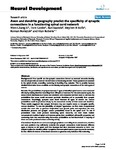Axon and dendrite geography predict the specificity of synaptic connections in a functioning spinal cord network
| dc.contributor.author | Li, WC | |
| dc.contributor.author | Cooke, T | |
| dc.contributor.author | Sautois, B | |
| dc.contributor.author | Soffe, S | |
| dc.contributor.author | Borisyuk, Roman | |
| dc.contributor.author | Roberts, A | |
| dc.date.accessioned | 2017-05-10T15:48:54Z | |
| dc.date.available | 2017-05-10T15:48:54Z | |
| dc.date.issued | 2007-01-01 | |
| dc.identifier.issn | 1749-8104 | |
| dc.identifier.issn | 1749-8104 | |
| dc.identifier.other | 17 | |
| dc.identifier.uri | http://hdl.handle.net/10026.1/9223 | |
| dc.description.abstract |
Background: How specific are the synaptic connections formed as neuronal networks develop and can simple rules account for the formation of functioning circuits? These questions are assessed in the spinal circuits controlling swimming in hatchling frog tadpoles. This is possible because detailed information is now available on the identity and synaptic connections of the main types of neuron. Results: The probabilities of synapses between 7 types of identified spinal neuron were measured directly by making electrical recordings from 500 pairs of neurons. For the same neuron types, the dorso-ventral distributions of axons and dendrites were measured and then used to calculate the probabilities that axons would encounter particular dendrites and so potentially form synaptic connections. Surprisingly, synapses were found between all types of neuron but contact probabilities could be predicted simply by the anatomical overlap of their axons and dendrites. These results suggested that synapse formation may not require axons to recognise specific, correct dendrites. To test the plausibility of simpler hypotheses, we first made computational models that were able to generate longitudinal axon growth paths and reproduce the axon distribution patterns and synaptic contact probabilities found in the spinal cord. To test if probabilistic rules could produce functioning spinal networks, we then made realistic computational models of spinal cord neurons, giving them established cell-specific properties and connecting them into networks using the contact probabilities we had determined. A majority of these networks produced robust swimming activity. Conclusion: Simple factors such as morphogen gradients controlling dorso-ventral soma, dendrite and axon positions may sufficiently constrain the synaptic connections made between different types of neuron as the spinal cord first develops and allow functional networks to form. Our analysis implies that detailed cellular recognition between spinal neuron types may not be necessary for the reliable formation of functional networks to generate early behaviour like swimming. | |
| dc.format.extent | 17-17 | |
| dc.format.medium | Electronic | |
| dc.language | en | |
| dc.language.iso | en | |
| dc.publisher | Springer Science and Business Media LLC | |
| dc.subject | Animals | |
| dc.subject | Axons | |
| dc.subject | Body Patterning | |
| dc.subject | Cell Differentiation | |
| dc.subject | Dendrites | |
| dc.subject | Functional Laterality | |
| dc.subject | Glutamic Acid | |
| dc.subject | Growth Cones | |
| dc.subject | Interneurons | |
| dc.subject | Larva | |
| dc.subject | Locomotion | |
| dc.subject | Nerve Net | |
| dc.subject | Neural Pathways | |
| dc.subject | Patch-Clamp Techniques | |
| dc.subject | Posterior Horn Cells | |
| dc.subject | Sensory Receptor Cells | |
| dc.subject | Spinal Cord | |
| dc.subject | Swimming | |
| dc.subject | Synapses | |
| dc.subject | Xenopus laevis | |
| dc.title | Axon and dendrite geography predict the specificity of synaptic connections in a functioning spinal cord network | |
| dc.type | journal-article | |
| dc.type | Journal Article | |
| dc.type | Research Support, Non-U.S. Gov't | |
| plymouth.author-url | https://www.webofscience.com/api/gateway?GWVersion=2&SrcApp=PARTNER_APP&SrcAuth=LinksAMR&KeyUT=WOS:000258981700001&DestLinkType=FullRecord&DestApp=ALL_WOS&UsrCustomerID=11bb513d99f797142bcfeffcc58ea008 | |
| plymouth.issue | 1 | |
| plymouth.volume | 2 | |
| plymouth.publication-status | Published | |
| plymouth.journal | Neural Development | |
| dc.identifier.doi | 10.1186/1749-8104-2-17 | |
| plymouth.organisational-group | /Plymouth | |
| plymouth.organisational-group | /Plymouth/Faculty of Science and Engineering | |
| plymouth.organisational-group | /Plymouth/Users by role | |
| plymouth.organisational-group | /Plymouth/Users by role/Researchers in ResearchFish submission | |
| dc.publisher.place | England | |
| dcterms.dateAccepted | 2007-09-10 | |
| dc.identifier.eissn | 1749-8104 | |
| dc.rights.embargoperiod | Not known | |
| rioxxterms.funder | Engineering and Physical Sciences Research Council | |
| rioxxterms.identifier.project | Brain-Inspired Neuronal Model of Attention and Memory | |
| rioxxterms.versionofrecord | 10.1186/1749-8104-2-17 | |
| rioxxterms.licenseref.uri | http://www.rioxx.net/licenses/all-rights-reserved | |
| rioxxterms.type | Journal Article/Review | |
| plymouth.funder | Brain-Inspired Neuronal Model of Attention and Memory::Engineering and Physical Sciences Research Council |


